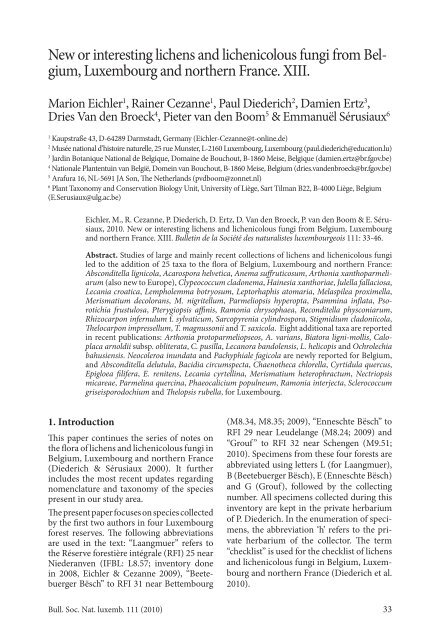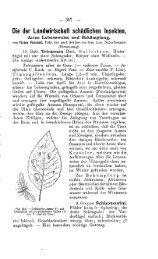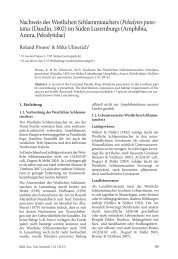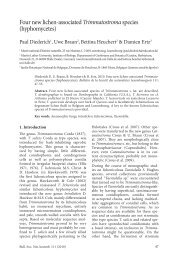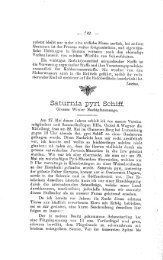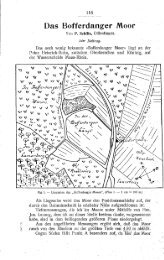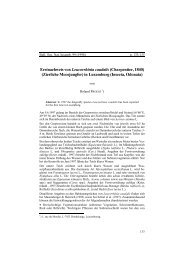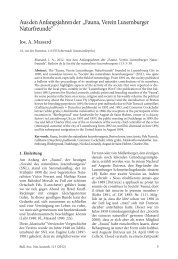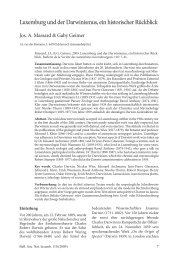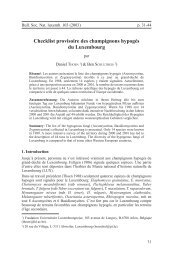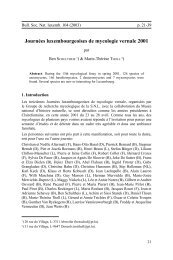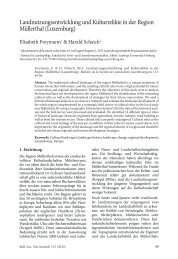New or interesting lichens and lichenicolous fungi from Bel ... - SNL
New or interesting lichens and lichenicolous fungi from Bel ... - SNL
New or interesting lichens and lichenicolous fungi from Bel ... - SNL
Create successful ePaper yourself
Turn your PDF publications into a flip-book with our unique Google optimized e-Paper software.
<strong>New</strong> <strong>or</strong> <strong>interesting</strong> <strong>lichens</strong> <strong>and</strong> <strong>lichenicolous</strong> <strong>fungi</strong> <strong>from</strong> <strong>Bel</strong>gium,<br />
Luxembourg <strong>and</strong> n<strong>or</strong>thern France. XIII.<br />
Marion Eichler 1 , Rainer Cezanne 1 , Paul Diederich 2 , Damien Ertz 3 ,<br />
Dries Van den Broeck 4 , Pieter van den Boom 5 & Emmanuël Sérusiaux 6<br />
1 Kaupstraße 43, D-64289 Darmstadt, Germany (Eichler-Cezanne@t-online.de)<br />
2 Musée national d’histoire naturelle, 25 rue Munster, L-2160 Luxembourg, Luxembourg (paul.diederich@education.lu)<br />
3 Jardin Botanique National de <strong>Bel</strong>gique, Domaine de Bouchout, B-1860 Meise, <strong>Bel</strong>gique (damien.ertz@br.fgov.be)<br />
4 Nationale Plantentuin van <strong>Bel</strong>gië, Domein van Bouchout, B-1860 Meise, <strong>Bel</strong>gium (dries.v<strong>and</strong>enbroeck@br.fgov.be)<br />
5 Arafura 16, NL-5691 JA Son, The Netherl<strong>and</strong>s (pvdboom@zonnet.nl)<br />
6 Plant Taxonomy <strong>and</strong> Conservation Biology Unit, University of Liège, Sart Tilman B22, B-4000 Liège, <strong>Bel</strong>gium<br />
(E.Serusiaux@ulg.ac.be)<br />
1. Introduction<br />
Eichler, M., R. Cezanne, P. Diederich, D. Ertz, D. Van den Broeck, P. van den Boom & E. Sérusiaux,<br />
2010. <strong>New</strong> <strong>or</strong> <strong>interesting</strong> <strong>lichens</strong> <strong>and</strong> <strong>lichenicolous</strong> <strong>fungi</strong> <strong>from</strong> <strong>Bel</strong>gium, Luxembourg<br />
<strong>and</strong> n<strong>or</strong>thern France. XIII. Bulletin de la Société des naturalistes luxembourgeois 111: 33-46.<br />
Abstract. Studies of large <strong>and</strong> mainly recent collections of <strong>lichens</strong> <strong>and</strong> <strong>lichenicolous</strong> <strong>fungi</strong><br />
led to the addition of 25 taxa to the fl<strong>or</strong>a of <strong>Bel</strong>gium, Luxembourg <strong>and</strong> n<strong>or</strong>thern France:<br />
Absconditella lignicola, Acarosp<strong>or</strong>a helvetica, Anema suffruticosum, Arthonia xanthoparmeliarum<br />
(also new to Europe), Clypeococcum cladonema, Hainesia xanth<strong>or</strong>iae, Julella fallaciosa,<br />
Lecania croatica, Lempholemma botryosum, Lept<strong>or</strong>haphis atomaria, Melaspilea proximella,<br />
Merismatium decol<strong>or</strong>ans, M. nigritellum, Parmeliopsis hyperopta, Psammina inflata, Ps<strong>or</strong>otichia<br />
frustulosa, Pterygiopsis affinis, Ramonia chryso phaea, Reconditella physconiarum,<br />
Rhizocarpon infernulum f. sylvaticum, Sarcopyrenia cylindrosp<strong>or</strong>a, Stigmidium cladonii cola,<br />
Thelocarpon impressellum, T. magnussonii <strong>and</strong> T. saxicola. Eight additional taxa are rep<strong>or</strong>ted<br />
in recent publications: Arthonia protoparmeliopseos, A. varians, Biat<strong>or</strong>a ligni-mollis, Caloplaca<br />
arnoldii subsp. obliterata, C. pusilla, Lecan<strong>or</strong>a b<strong>and</strong>olensis, L. helicopis <strong>and</strong> Ochrolechia<br />
bahu siensis. Neocoleroa inundata <strong>and</strong> Pachyphiale fagicola are newly rep<strong>or</strong>ted f<strong>or</strong> <strong>Bel</strong>gium,<br />
<strong>and</strong> Absconditella delutula, Bacidia circumspecta, Chaenotheca chl<strong>or</strong>ella, Cyrtidula quercus,<br />
Epigloea filifera, E. renitens, Lecania cyrtellina, Merismatium heterophractum, Nectriopsis<br />
micareae, Parmelina quercina, Phaeocalicium populneum, Ramonia interjecta, Sclerococcum<br />
griseisp<strong>or</strong>odochium <strong>and</strong> Thelopsis rubella, f<strong>or</strong> Luxembourg.<br />
This paper continues the series of notes on<br />
the fl<strong>or</strong>a of <strong>lichens</strong> <strong>and</strong> <strong>lichenicolous</strong> <strong>fungi</strong> in<br />
<strong>Bel</strong>gium, Luxembourg <strong>and</strong> n<strong>or</strong>thern France<br />
(Diederich & Sérusiaux 2000). It further<br />
includes the most recent updates regarding<br />
nomenclature <strong>and</strong> taxonomy of the species<br />
present in our study area.<br />
The present paper focuses on species collected<br />
by the first two auth<strong>or</strong>s in four Luxembourg<br />
f<strong>or</strong>est reserves. The following abbreviations<br />
are used in the text: “Laangmuer” refers to<br />
the Réserve f<strong>or</strong>estière intégrale (RFI) 25 near<br />
Niederanven (IFBL: L8.57; invent<strong>or</strong>y done<br />
in 2008, Eichler & Cezanne 2009), “Beetebuerger<br />
Bësch” to RFI 31 near Bettembourg<br />
(M8.34, M8.35; 2009), “Enneschte Bësch” to<br />
RFI 29 near Leudelange (M8.24; 2009) <strong>and</strong><br />
“Grouf” to RFI 32 near Schengen (M9.51;<br />
2010). Specimens <strong>from</strong> these four f<strong>or</strong>ests are<br />
abbreviated using letters L (f<strong>or</strong> Laangmuer),<br />
B (Beetebuerger Bësch), E (Enneschte Bësch)<br />
<strong>and</strong> G (Grouf), followed by the collecting<br />
number. All specimens collected during this<br />
invent<strong>or</strong>y are kept in the private herbarium<br />
of P. Diederich. In the enumeration of specimens,<br />
the abbreviation ‘h’ refers to the private<br />
herbarium of the collect<strong>or</strong>. The term<br />
“checklist” is used f<strong>or</strong> the checklist of <strong>lichens</strong><br />
<strong>and</strong> <strong>lichenicolous</strong> <strong>fungi</strong> in <strong>Bel</strong>gium, Luxembourg<br />
<strong>and</strong> n<strong>or</strong>thern France (Diederich et al.<br />
2010).<br />
Bull. Soc. Nat. luxemb. 111 (2010) 33
2. Survey of other publications on the<br />
lichen fl<strong>or</strong>a <strong>and</strong> vegetation of the study<br />
area<br />
Boulanger et al. (2009) published a rep<strong>or</strong>t<br />
<strong>from</strong> a lichenological excursion done in<br />
the Boulonnais (France, Pas-de-Calais)<br />
in 2008. Several species not previously<br />
accepted in the checklist were mentioned.<br />
In a supplement to this first paper,<br />
Boulanger et al. (2010) gave additional<br />
inf<strong>or</strong>mation on some rare <strong>or</strong> problematic<br />
taxa. Arthonia varians (Ach.) Nyl.,<br />
a species usually growing on the saxicolous<br />
Lecan<strong>or</strong>a rupicola (incl. L. bicincta)<br />
(Grube 2007), although rep<strong>or</strong>ted <strong>from</strong><br />
other hosts, such as L. actophila (Clauzade<br />
et al. 1989) <strong>and</strong> L. helicopis (Wahlenb.)<br />
Ach. (Ihlen & Wedin 2008), is rep<strong>or</strong>ted<br />
<strong>from</strong> Lecan<strong>or</strong>a helicopis (Boulanger et al.<br />
2010) <strong>and</strong> is new to the checklist area. The<br />
host, Lecan<strong>or</strong>a helicopis, is as well new<br />
to the checklist area. Diplotomma glaucoatrum<br />
(Nyl.) is a non-validly published<br />
new combination of Buellia glaucoatra<br />
(Nyl.) Clauzade; this species is considered<br />
as a synonym of D. alboatrum (Hoffm.)<br />
Flot. by N<strong>or</strong>din (2000), but as a distinct<br />
species by Roux (pers. comm.), distinguished<br />
by a thicker thallus <strong>and</strong> the occurrence<br />
on coastal rocks; Boulanger et al.<br />
(2009, 2010) state that the species has been<br />
observed in 1989 near cap Griz-Nez, but<br />
in the absence of any reference specimens<br />
it is wise to consider this rep<strong>or</strong>t as doubtful.<br />
The rep<strong>or</strong>t by Boulanger et al. (2009)<br />
of Lecania aipospila (Wahlenb.) Th.Fr. is<br />
not supp<strong>or</strong>ted by any herbarium specimen<br />
<strong>and</strong> theref<strong>or</strong>e has to be removed <strong>from</strong> the<br />
checklist (Boulanger et al. 2010); a previous<br />
Boulonnais rec<strong>or</strong>d of this species (Van<br />
den Broeck et al. 2009) proved to represent<br />
L. cf. fructigena (Diederich et al. 2009).<br />
Boulanger et al. (2009: 175, 181) doubtfully<br />
rep<strong>or</strong>ted Lecan<strong>or</strong>a ripartii Lamy<br />
(they hesitated between L. ripartii <strong>and</strong> L.<br />
atrynea, the latter being a m<strong>or</strong>photype<br />
of L. cenisia), illustrated by a photograph<br />
done near cap Griz-Nez; later, Boulanger<br />
et al. (2010) stated that this was a misidentification<br />
f<strong>or</strong> L. campestris (Schaer.) Hue.<br />
Opegrapha trifurcata Hepp, keyed out by<br />
Clauzade & Roux (1985), might be identi-<br />
cal to the Boulonnais material published<br />
by Sparrius et al. (2002) as Opegrapha saxatilis<br />
DC. s.l.; a m<strong>or</strong>e detailed study of this<br />
group is urgently needed; following Roux<br />
(pers. comm.), the type of O. saxatilis<br />
[kept in G] belongs to the <strong>lichenicolous</strong> O.<br />
rupestris Pers., whilst the type of O. trifurcata<br />
is a species closely related to Arthonia<br />
atra (Pers.) A.Schneid. Xanth<strong>or</strong>ia aureola<br />
(Ach.) Erichsen has never been c<strong>or</strong>rectly<br />
rep<strong>or</strong>ted <strong>from</strong> the Boulonnais; the recent<br />
rep<strong>or</strong>t by Van den Broeck et al. (2009)<br />
proved to be m<strong>or</strong>e strongly pigmented X.<br />
parietina; the rep<strong>or</strong>t by Boulanger et al.<br />
(2009) is unf<strong>or</strong>tunately not sustained by<br />
any herbarium specimen (Boulanger pers.<br />
comm.), all specimens collected belonging<br />
to X. calcicola <strong>or</strong> X. parietina (Boulanger<br />
et al. 2010).<br />
Hellemans & Stappaerts (2009) discovered<br />
Stereocaulon pileatum on a brick wall as new<br />
to Fl<strong>and</strong>ers.<br />
Van den Broeck et al. (2009) presented the<br />
rep<strong>or</strong>t <strong>from</strong> a lichenological excursion done<br />
in 2008 near De Panne (<strong>Bel</strong>gium, Mar. <strong>and</strong><br />
Brab.). Many species are new rec<strong>or</strong>ds f<strong>or</strong><br />
Fl<strong>and</strong>ers <strong>or</strong> f<strong>or</strong> the Maritime <strong>or</strong> Brabant<br />
phytogeographical districts. Further rep<strong>or</strong>ts<br />
<strong>from</strong> excursions in Fl<strong>and</strong>ers refer to the surrounding<br />
of Mol (Van den Broeck 2009a),<br />
Balen <strong>and</strong> Meerhout (Van den Broeck<br />
2009b), Tongerlo (Van den Broeck & Hellemans<br />
2009) <strong>and</strong> Serskamp (Stieperaere &<br />
Van den Broeck 2009).<br />
Bertr<strong>and</strong> et al. (2010) present a remarkable<br />
revision of the po<strong>or</strong>ly known Lecan<strong>or</strong>a<br />
b<strong>and</strong>olensis B. de Lesd. This species belongs<br />
to the L. dispersa group <strong>and</strong> is confined to<br />
coastal rocks. The auth<strong>or</strong>s have studied a<br />
specimen <strong>from</strong> our study area, collected in<br />
1989 near Cap Gris-Nez by C. Van Haluwyn.<br />
We have examined an additional<br />
specimen (France, Mar., Pas-de-Calais,<br />
entre Ambleteuse et Wimereux, rochers au<br />
b<strong>or</strong>d de la mer à 600 m au N de la Pointe<br />
aux Oies, E22.35, alt. 5 m, rochers de grès<br />
émergés en permanence, 2000, P. Diederich<br />
14444, h).<br />
Sérusiaux et al. (2010) rep<strong>or</strong>t the discovery<br />
of Biat<strong>or</strong>a ligni-mollis T. Sprib. & Printzen<br />
<strong>from</strong> <strong>Bel</strong>gium (Ard.), where it was collected<br />
on an old Quercus in the f<strong>or</strong>êt d’Anlier.<br />
34 Bull. Soc. Nat. luxemb. 111 (2010)
3. Taxonomical <strong>and</strong> nomenclatural<br />
changes<br />
Jørgensen (2007) suggests that the c<strong>or</strong>rect<br />
name f<strong>or</strong> Synalissa symph<strong>or</strong>ea auct. is S.<br />
ramulosa (Hoffm. ex Bernh.) Fr.<br />
Baloch et al. (2009) show that Bryophagus<br />
is a synonym of Cryptodiscus, <strong>and</strong> consequently<br />
they propose the new combination<br />
C. gloeocapsa (Arnold) Baloch, Gilenstam &<br />
Wedin f<strong>or</strong> B. gloeocapsa Arnold.<br />
Etayo & Diederich (2009) describe Arthonia<br />
protoparmeliopseos Etayo & Diederich, <strong>lichenicolous</strong><br />
on Protoparmeliopsis (= Lecan<strong>or</strong>a)<br />
muralis, <strong>from</strong> Spain <strong>and</strong> Luxembourg (L<strong>or</strong>r.).<br />
Gaya (2009) revised the Caloplaca saxicola<br />
group. Three species are rep<strong>or</strong>ted <strong>from</strong> our<br />
checklist area: C. arnoldii subsp. obliterata<br />
(Pers.) Gaya (<strong>from</strong> Luxembourg, Ard.), C.<br />
pusilla (A.Massal.) Zahlbr. (<strong>from</strong> France,<br />
Mar.) <strong>and</strong> C. saxicola (Hoffm.) N<strong>or</strong>din (<strong>from</strong><br />
France, Mar.), the two f<strong>or</strong>mer being new f<strong>or</strong><br />
our checklist. A revision of the entire material<br />
<strong>from</strong> our study area still remains to be done.<br />
Petractis hypoleuca (Ach.) Vězda is better<br />
included in Gyalecta, as G. hypoleuca (Ach.)<br />
Zahlbr. (Gilbert et al. 2009).<br />
Kukwa (2009) rep<strong>or</strong>ts Ochrolechia bahu siensis<br />
H.Magn. <strong>from</strong> Luxembourg. This c<strong>or</strong>responds<br />
to O. <strong>and</strong>rogyna C sensu Tønsberg (1992). The<br />
species is not rare in Luxembourg, but a study<br />
of the entire material of O. <strong>and</strong>rogyna s.lat.<br />
<strong>from</strong> our area of study remains to be done.<br />
Orange et al. (2009) consider that Verrucaria<br />
acrotella auct., recently accepted as a distinct<br />
species, mainly by Dutch auth<strong>or</strong>s, is a synonym<br />
of V. murina auct.<br />
Roux (2009) explains that the name Zwackhiomyces<br />
immersus (Arnold) Grube & Triebel<br />
should be replaced by the earlier Z. socialis<br />
(Körb.) Cl.Roux. That species appears to be confined<br />
to Clauzadea species. The material <strong>from</strong><br />
our checklist area, which only occurs on Bacidia<br />
bagliettoana, might represent a distinct species.<br />
The new combination Llimoniella terricola<br />
(Rehm ex Arnold) M.Schultz, Diederich &<br />
Ertz is proposed f<strong>or</strong> the species previously<br />
named Gelatinopsis leptogii Ertz & Diederich<br />
(Diederich et al. 2010), of which the type is<br />
<strong>lichenicolous</strong> on Epiphloea byssina in <strong>Bel</strong>gium.<br />
Although Spier & Aptroot (2007) suggested<br />
Cladonia rei Schaer. to be a synonym of C.<br />
subulata (L.) F.H.Wigg., Dolnik et al. (2010)<br />
demonstrate that these are two phylogenetically<br />
distinct species, easily recognized by the<br />
presence <strong>or</strong> absence of homosekikaic acid.<br />
Fryday & Lendemer (2010) transfer Catillochroma<br />
pulverea (B<strong>or</strong>rer) Kalb to Megalaria, as<br />
M. pulverea (B<strong>or</strong>rer) Hafellner & E. Schreiner.<br />
Hauck & Wirth (2010) combined several<br />
Bacidia species in Bacidina, amongst which<br />
the following are known <strong>from</strong> our study<br />
area: Bacidina adastra (Sparrius & Aptroot)<br />
M.Hauck & V.Wirth, B. br<strong>and</strong>ii (Coppins<br />
& van den Boom) M.Hauck & V.Wirth, B.<br />
saxenii (Erichsen) M.Hauck & V.Wirth <strong>and</strong><br />
B. sulphurella (Samp.) M.Hauck & V.Wirth.<br />
Kocourková & Knudsen (2010) show that the<br />
fungus on Pertusaria lactea frequently called<br />
Stigmidium aggregatum (Mudd) D.Hawksw.<br />
has to be called S. eucline (Nyl.) Vězda.<br />
N<strong>or</strong>din et al. (2010) present a phylogenetic<br />
analysis of Aspicilia <strong>and</strong> Megasp<strong>or</strong>aceae.<br />
Several Aspicilia species present in our study<br />
area are transferred to the genus Circinaria:<br />
C. caesiocinerea (Malbr.) A.N<strong>or</strong>din, S.Savić<br />
& Tibell, C. calcarea (L.) A.N<strong>or</strong>din, S.Savić<br />
& Tibell, C. cont<strong>or</strong>ta (Hoffm.) A.N<strong>or</strong>din,<br />
S.Savić & Tibell <strong>and</strong> C. gibbosa (Ach.)<br />
A.N<strong>or</strong>din, S.Savić & Tibell, as well as C.<br />
cupreo grisea (Th.Fr.) A.N<strong>or</strong>din, S.Savić<br />
& Tibell, a species rep<strong>or</strong>ted as occurring<br />
doubtfully in this area. Aspicilia rece dens<br />
(Tayl<strong>or</strong>) Arnold is transferred to Lobothallia,<br />
as L. recedens (Tayl<strong>or</strong>) A.N<strong>or</strong>din,<br />
S.Savić & Tibell. Aspicilia cinerea (L.) Körb.,<br />
the generic type, is the only species <strong>from</strong> our<br />
study area remaining with certainty in Aspicilia,<br />
while A. aquatica Körb. <strong>and</strong> A. cont<strong>or</strong>ta<br />
subsp. hoffmaniana S.Ekman & Fröberg have<br />
not been discussed in that paper. As some of<br />
these genera are po<strong>or</strong>ly distinguished using<br />
m<strong>or</strong>phological characters, <strong>and</strong> as the type<br />
of Aspicilia subgen. Pachyothallia was not<br />
included in the molecular analysis, we prefer<br />
to await additional studies, including m<strong>or</strong>e<br />
species, bef<strong>or</strong>e accepting all these changes.<br />
Timdal (2010) describes the new genus P<strong>or</strong>pidinia<br />
f<strong>or</strong> the species Toninia tumidula, with<br />
the new combination P. tumidula (Sw.) Timdal.<br />
Bull. Soc. Nat. luxemb. 111 (2010) 35
4. <strong>New</strong> <strong>or</strong> <strong>interesting</strong> rep<strong>or</strong>ts<br />
Absconditella delutula (Nyl.) Coppins &<br />
H.Kilias<br />
Luxembourg, L<strong>or</strong>r.: Laangmuer, on s<strong>and</strong>stone<br />
pebbles, L7449, L7469; on dead wood, L7470;<br />
Grouf, on dead wood of Picea, G10.<br />
This species was known <strong>from</strong> <strong>Bel</strong>gium (Ertz<br />
et al. 2008, Sérusiaux et al. 2006) <strong>and</strong> is here<br />
rep<strong>or</strong>ted as new to Luxembourg.<br />
Absconditella lignicola Vězda & Pišút<br />
Luxembourg, L<strong>or</strong>r.: Beetebuerger Bësch (M8.35), on<br />
Picea wood, B1; Grouf, on dead wood of Fagus, G11.<br />
A rarely collected, but probably m<strong>or</strong>e widespread<br />
<strong>and</strong> much overlooked species that is<br />
new to the checklist area.<br />
Acarosp<strong>or</strong>a helvetica H.Magn.<br />
Luxembourg, L<strong>or</strong>r.: N of Folkendange, Brouderbur<br />
(K8.56), on a s<strong>and</strong>stone rock, 1981, P. Diederich<br />
3423 (h).<br />
France, Mosan: Ardennes, Chooz, rochers de Petit-<br />
Chooz sur la rive droite de la Meuse, face au pont<br />
(J5.35), affleurement de roches de l’Emsien supérieur<br />
(Grauwacke de Hierges), schistes argilo-calcareux,<br />
facilement décalcifiés, 1999, P. Diederich 16306 (h).<br />
This species was included within the concept<br />
of A. complanata H.Magn. by Clauzade<br />
& Roux (1982), but has recently been recognized<br />
as a distinct taxon (Roux 2007). It is<br />
new to the checklist area. Both specimens<br />
have been identified by C. Roux.<br />
Anema suffruticosum P. M<strong>or</strong>reno & Egea<br />
France, Mosan: Ardennes, Givet, rive gauche de<br />
la Meuse à la s<strong>or</strong>tie amont de la ville, sous le f<strong>or</strong>t<br />
de Charle mont (J5.25), affleurements de calcaires<br />
com pacts du Givetien sur flanc sud avec suintements<br />
d’eau temp<strong>or</strong>aires, 1999, P. Diederich 15693 (h).<br />
A very rare Mediterranean species, initially<br />
described <strong>from</strong> SE Spain (M<strong>or</strong>eno & Egea<br />
1992), later also discovered in France (Var)<br />
(Roux et al. 2003) <strong>and</strong> Italy (Nimis & Tretiach<br />
2004). Although our material has been<br />
identified by M. Schultz as A. cf. suffruticosum,<br />
we accept this identification as it is the<br />
best hypothesis with our current knowledge<br />
on the taxonomy of this difficult group. The<br />
species is new to our checklist area.<br />
Arthonia xanthoparmeliarum Etayo<br />
Luxembourg, Ard.: Bourscheid, along road to<br />
Ettelbruck, near Michelau, W exposed schistose<br />
outcrops along road (K8.45), on Xanthoparmelia<br />
conspersa, 2002, P. & B. van den Boom 29888 (h).<br />
This <strong>lichenicolous</strong> ascomycete was described<br />
<strong>from</strong> Chile on saxicolous Xanthoparmelia<br />
(Etayo & Sancho 2008) <strong>and</strong> has also been<br />
rep<strong>or</strong>ted <strong>from</strong> the U.S.A. (Calif<strong>or</strong>nia) by<br />
Kocourková (2009). It is new to Europe.<br />
Arthopyrenia salicis A.Massal.<br />
Luxembourg, L<strong>or</strong>r.: Enneschte Bësch, on young Fraxinus<br />
by a pond, E3, P. Diederich 16811 (h); Beetebuerger<br />
Bësch, on young Fraxinus <strong>and</strong> Quercus, field observation;<br />
Grouf, on young Fraxinus, field observation.<br />
This rare species was previously known <strong>from</strong><br />
one Luxembourg locality (Ard.) on Carpinus<br />
along a stream (Sérusiaux et al. 1999).<br />
Bacidia circumspecta (Vain.) Malme<br />
Luxembourg, L<strong>or</strong>r.: Laangmuer, on the base of<br />
Fagus, L7457.<br />
Fig. 1. Anema suffruticosum,<br />
a very rare Mediterran<br />
ean lichen, discovered<br />
in n<strong>or</strong>thern France (Ardennes)<br />
(Diederich 15693).<br />
Scale bar = 0.5 mm.<br />
36 Bull. Soc. Nat. luxemb. 111 (2010)
Fig. 2. Hainesia xanth<strong>or</strong>iae, a probably widespread, but<br />
over looked <strong>lichenicolous</strong> fungus, usually growing on Xanth<strong>or</strong>ia<br />
parietina (Diederich 16955). Scale bar = 0.5 mm.<br />
A relatively rare species, known <strong>from</strong> a<br />
few <strong>Bel</strong>gian localities (Ertz et al. 2008) <strong>and</strong><br />
rep<strong>or</strong>ted here as new to Luxembourg.<br />
Chaenotheca chl<strong>or</strong>ella (Ach.) Müll.Arg.<br />
Luxembourg, L<strong>or</strong>r.: Beetebuerger Bësch (M8.34,<br />
M8.35), on Fagus wood, B12, B13.<br />
<strong>New</strong> to Luxembourg.<br />
Clypeococcum cladonema (Wedd.) D.Hawksw.<br />
<strong>Bel</strong>gium, Mosan: Rouillon, les Tiennes de Rouillon<br />
(H5.16), on an exposed siliceous rock, on Xanthoparmelia<br />
loxodes, 2008, D. Ertz 12230 (BR).<br />
A <strong>lichenicolous</strong> pyrenomycete, initially<br />
described <strong>from</strong> Xanthoparmelia species with<br />
a brown thallus, later also rec<strong>or</strong>ded on thalli<br />
of Cetrelia (e.g., Hafellner 1995). <strong>New</strong> to the<br />
checklist area.<br />
Collema fragile Tayl<strong>or</strong><br />
<strong>Bel</strong>gium, Mosan: Anseremme, Roches de Freyr,<br />
au sommet de l‘affleurement (H5.57), 2009, D.<br />
Ertz 15196 (BR); Dinant, à l‘ouest d‘Anseremme,<br />
Rochers de Moniat (H5.47), 2009, D. Ertz 15232<br />
& J.-P. Duvivier (BR); Anseremme, anc. Prieuré,<br />
cemetery (H5.47), on the ground with Leptogium<br />
teretiusculum, 2009, D. Van den Broeck 3291 (h).<br />
This species was rep<strong>or</strong>ted as new to <strong>Bel</strong>gium<br />
by Ertz et al. (2008), based on a 1962 collection.<br />
Several recent specimens confirm that<br />
the species still exists in <strong>Bel</strong>gium (Mosan).<br />
Cyrtidula quercus (A.Massal.) Minks<br />
Luxembourg, L<strong>or</strong>r.: Beetebuerger Bësch (M8.34),<br />
on branches of young Quercus, B19; Enneschte<br />
Bësch, on branches of Quercus, E20; Grouf, on<br />
Fig. 3. Hainesia xanth<strong>or</strong>iae, section through conidioma,<br />
showing hyaline, acicular conidia (Diederich 16955).<br />
Scale bar = 50 μm.<br />
branches of Populus, G12, on branches of young<br />
Quercus, G13.<br />
A non-lichenized species, although mainly<br />
studied by lichenologists, probably often<br />
overlooked. <strong>New</strong> to Luxembourg.<br />
Epigloea filifera Döbbeler<br />
Luxembourg, L<strong>or</strong>r.: Laangmuer, on bark of fallen<br />
Picea, L7388.<br />
A doubtfully lichenized, algicolous fungus,<br />
previously known <strong>from</strong> <strong>Bel</strong>gium (Ard.)<br />
(Sérusiaux et al. 1999). <strong>New</strong> to Luxembourg.<br />
Epigloea renitens (Grummann) Döbbeler<br />
Luxembourg, L<strong>or</strong>r.: Laangmuer, on soil <strong>and</strong> plant<br />
debris, L7458; Grouf, on dead wood, G14.<br />
Another algicolous species that was previously<br />
known in our study area <strong>from</strong> one<br />
locality in <strong>Bel</strong>gium (Mosan) (Sérusiaux et al.<br />
2003). <strong>New</strong> to Luxembourg.<br />
Hainesia xanth<strong>or</strong>iae Brackel<br />
Luxembourg, L<strong>or</strong>r.: L<strong>or</strong>entzweiler (L8.46), on<br />
Syringa in a garden, on Xanth<strong>or</strong>ia parietina, 2010,<br />
P. Diederich 16906 (h); Bertrange, Tossenberg<br />
(M8.14), on branches of Fraxinus, on X. parietina,<br />
2010, P. Diederich 16934 (h); N of Strassen<br />
(M8.14), on branches of Fraxinus, on X. parietina,<br />
2010, P. Diederich 16959 (h).<br />
This recently described <strong>lichenicolous</strong> anam<strong>or</strong>phic<br />
fungus, previously known <strong>from</strong> Germany<br />
<strong>and</strong> Greenl<strong>and</strong>, mainly develops on<br />
thalli <strong>and</strong> apothecia of Xanth<strong>or</strong>ia species<br />
(Brackel 2009). The repeated discovery in villages<br />
suggests that it must be widespread <strong>and</strong><br />
Bull. Soc. Nat. luxemb. 111 (2010) 37
probably rather common, but overlooked.<br />
The species is new to the checklist area.<br />
Julella fallaciosa (Arnold) R.C.Harris<br />
Luxembourg, L<strong>or</strong>r.: Grouf, on branches of Fagus,<br />
G15, G21.<br />
A probably non-lichenized species, although<br />
frequently studied by lichenologists. <strong>New</strong> to<br />
the checklist area.<br />
Lecania croatica (Zahlbr.) Kotlov<br />
= Catillaria croatica Zahlbr.<br />
<strong>Bel</strong>gium, Mosan: Eprave, SW of Bois de Noulaiti,<br />
left side of the river Lomme (J6.24), disturbed<br />
woodl<strong>and</strong> along the river, with Ulmus laevis <strong>and</strong><br />
including Populus plantations, 1997, E. Sérusiaux<br />
(LG); Wauls<strong>or</strong>t, left bank of the Meuse, Fond des<br />
Vaux, “Petit Bois” (H5.56), mixed woodl<strong>and</strong> with<br />
boles of Quercus, with a dense Buxus underst<strong>or</strong>y<br />
in a small, rather deep valley, on Tilia, 1994, P.<br />
Diederich 4982 (h) & E. Sérusiaux (LG). Ard.: S of<br />
Neufchâteau, Rossignol, centre of village (L7.11),<br />
on Fraxinus in parkl<strong>and</strong>, 2006, P. van den Boom<br />
37074 (h).<br />
Luxembourg, L<strong>or</strong>r.: Beetebuerger Bësch (M8.34,<br />
M8.35), on Fagus, B63, B68; on Sambucus, B70;<br />
Enneschte Bësch, on Carpinus, E58; on Acer<br />
campestre, E59; on Fraxinus, E60, E61; Grouf, on<br />
Acer campestre, G16.<br />
France, L<strong>or</strong>r.: Dépt. Meuse, S de Montmédy,<br />
entre Iré-les-Prés et Iré-le-Sec, bois de Juvigny<br />
(M6.58), frênaie-aulnaie de fond de vallée, sur<br />
C<strong>or</strong>ylus, 1989, E. Sérusiaux 10407-b (LG).<br />
This is a very inconspicuous, generally sterile,<br />
c<strong>or</strong>ticolous lichen with a s<strong>or</strong>ediate thallus<br />
that might often have been overlooked. It<br />
was previously known <strong>from</strong> several Central<br />
<strong>or</strong> Eastern European countries <strong>and</strong> <strong>from</strong> the<br />
U.S.A. (Cezanne et al. 2008, Hafellner et al.<br />
2005, Harris & Lendemer 2010). The species<br />
is new to the checklist area. The identification<br />
of several Luxembourg specimens has<br />
kindly been confirmed by C. Printzen.<br />
Lecania cyrtellina (Nyl.) S<strong>and</strong>st.<br />
Luxembourg, L<strong>or</strong>r.: Enneschte Bësch, on Acer<br />
campestre, E7883; Laangmuer, on Fagus, L7509;<br />
Strassen, 400 m NE of Scouts home (M8.14), on<br />
Sambucus, 2009, P. Diederich 16814 (h, herb. van<br />
den Boom).<br />
A relatively rare, probably frequently overlooked<br />
species. <strong>New</strong> to Luxembourg.<br />
Lempholemma botryosum (A.Massal.) Zahlbr.<br />
France, Mosan: Ardennes, Givet, rive gauche de<br />
la Meuse à la s<strong>or</strong>tie amont de la ville, sous le f<strong>or</strong>t<br />
de Charlemont (J5.25), affleurements de calcaires<br />
compacts du Givetien sur flanc sud et avec suintements<br />
d’eau temp<strong>or</strong>aires, mais fréquents, 1999,<br />
P. Diederich 15699 (h).<br />
A rare cyanobacterial species, here rep<strong>or</strong>ted<br />
as new to the checklist area. Material identified<br />
by M. Schultz.<br />
Lept<strong>or</strong>haphis atomaria (Ach.) Szatala<br />
Luxembourg, L<strong>or</strong>r.: W of Bertrange, Houscht<br />
(M8.13), on branches of Populus, 2010, P. Diederich<br />
16927 (h, BR, herb. Eichler-Cezanne).<br />
This ascomycete is probably not <strong>or</strong> only facultatively<br />
lichenized, although usually associated<br />
with Trentepohlia (Aguirre-Hudson<br />
1991). It was rep<strong>or</strong>ted <strong>from</strong> Luxembourg by<br />
Koltz (1897: 310), but this was not accepted<br />
by Diederich & Sérusiaux (2000), as no<br />
specimen seems to exist in LUX. The species<br />
is theref<strong>or</strong>e new to our study area.<br />
Melaspilea proximella (Nyl.) Nyl.<br />
Luxembourg, L<strong>or</strong>r.: Beetebuerger Bësch (M8.35),<br />
on old Quercus, B26; Laangmuer, on Quercus,<br />
L7453; Grouf, on Quercus, G17.<br />
A facultatively lichenized fungus that is new<br />
to our checklist area.<br />
Merismatium decol<strong>or</strong>ans (Arnold) Triebel<br />
=? Sphaerulina intermedia Vouaux<br />
Luxembourg, Ard.: Esch-sur-Sûre, ruins of old<br />
castle (K8.32), on Leptogium gelatinosum <strong>and</strong><br />
Agonimia tristicula, 2002, P. Diederich 16786 (h).<br />
The ascosp<strong>or</strong>es of this <strong>lichenicolous</strong> pyrenomycete<br />
were said to be pale to medium<br />
brown (Triebel 1989). In our specimen, they<br />
are m<strong>or</strong>e <strong>or</strong> less hyaline, almost surely as<br />
they are young <strong>and</strong> immature. Although the<br />
type of Sphaerulina intermedia Vouaux is<br />
lost, the <strong>or</strong>iginal description (Vouaux 1913:<br />
37) suggests that this represents a synonym<br />
of M. decol<strong>or</strong>ans in which the ascosp<strong>or</strong>es<br />
were as well immature <strong>and</strong> theref<strong>or</strong>e almost<br />
colourless (yellowish when old); that taxon<br />
was described <strong>from</strong> a thallus of “Leptogium<br />
microscopicum” in n<strong>or</strong>thern France (Mar.).<br />
The species is new to the checklist area.<br />
38 Bull. Soc. Nat. luxemb. 111 (2010)
Merismatium heterophractum (Nyl.) Vouaux<br />
Luxembourg, L<strong>or</strong>r.: Pétange, Prënzebierg (M8.31),<br />
dans une pelouse de mousses et de Cladonia sur<br />
roche, sur Cladonia rei, 2010, P. Diederich 16956<br />
(h).<br />
This <strong>lichenicolous</strong> pyrenomycete was known<br />
<strong>from</strong> France (L<strong>or</strong>r.) on Bilimbia sabulet<strong>or</strong>um<br />
(Diederich et al. 1991). Cladonia is a new host<br />
genus. The species is new to Luxembourg.<br />
Merismatium nigritellum (Nyl.) Vouaux<br />
= Merismatium lopadii (Anzi) Zopf<br />
=? Polyblastia gothica Th. Fr.<br />
France, Mosan: Ardennes, Chooz, rochers de<br />
Petit-Chooz sur la rive droite de la Meuse, face au<br />
pont (J5.35), schistes argilo-calcareux, sur Leptogium<br />
lichenoides, 1999, P. Diederich 16284 (h).<br />
This <strong>lichenicolous</strong> species was rep<strong>or</strong>ted<br />
<strong>from</strong> Luxembourg by Diederich (1986)<br />
as M. lopadii, based on two specimens on<br />
Lecan<strong>or</strong>a conizaeoides. Diederich & Sérusiaux<br />
(2000) regarded this rec<strong>or</strong>d as dubious,<br />
as the ascomata are smaller (c. 70 μm<br />
diam.) than in typical M. nigritellum <strong>and</strong><br />
the ascosp<strong>or</strong>es narrower <strong>and</strong> with a lower<br />
number of cells. The identity of these two<br />
specimens requires further studies.<br />
Diederich et al. (2009) published Polyblastia<br />
gothica <strong>from</strong> Luxembourg, based on a specimen<br />
growing on soil between thalli of Leptogium<br />
pulvinatum. Hafellner (2010) suggests<br />
that P. gothica is almost surely a synonym<br />
of M. nigritellum. The French specimen<br />
cited above is <strong>lichenicolous</strong> on Leptogium<br />
lichenoides. The ascosp<strong>or</strong>es are much paler<br />
than in the Luxembourg specimen of P.<br />
gothica, which might just reflect a different<br />
degree of maturity of the ascomata, but f<strong>or</strong><br />
the rest fits M. nigritellum perfectly. We propose<br />
theref<strong>or</strong>e to accept Merismatium nigritellum<br />
as occurring in our checklist area,<br />
with P. gothica as a possible synonym.<br />
Nectriopsis micareae Diederich, van den<br />
Boom & G. Ernst<br />
Luxembourg, Ard.: E of Clervaux, E of Roder,<br />
Reiteschbierg, path S of brooklet Kënzelbaach<br />
(J8.45), on exposed roots of Picea, on Micarea<br />
viridileprosa, 2007, P. van den Boom 38300 (h).<br />
This <strong>lichenicolous</strong> ascomycete is relatively<br />
rare <strong>and</strong> appears to be confined to Micarea<br />
viridileprosa. It was known <strong>from</strong> one locality<br />
in <strong>Bel</strong>gium (Camp.) <strong>and</strong> one in n<strong>or</strong>thern<br />
France (Mar.) (Sparrius et al. 2002), <strong>and</strong> is<br />
rep<strong>or</strong>ted here as new to Luxembourg.<br />
Neocoleroa inundata (Vain.) Diederich<br />
<strong>Bel</strong>gium, Fl.: E of Gent, centre of Lokeren (Oost-<br />
Vla<strong>and</strong>eren), old churchyard (C3.57), on Bacidina<br />
caligans, 2010, P. van den Boom 44822 (h).<br />
A rarely collected, but probably m<strong>or</strong>e widespread<br />
<strong>lichenicolous</strong> ascomycete, here rep<strong>or</strong>ted<br />
as new to <strong>Bel</strong>gium.<br />
Pachyphiale fagicola (Hepp) Zwackh<br />
<strong>Bel</strong>gium, Mosan: Wauls<strong>or</strong>t (Hastière), village de<br />
vacances de Wauls<strong>or</strong>t, Sur le Pairy 1 (H5.56), on<br />
Fraxinus, 2009, D. Van den Broeck 3337 (h).<br />
A rare species, previously known <strong>from</strong> three<br />
localities in Luxembourg <strong>and</strong> n<strong>or</strong>thern<br />
France (Diederich et al. 2006, van den Boom<br />
et al. 1994). <strong>New</strong> to <strong>Bel</strong>gium.<br />
Parmelina quercina (Willd.) Hale var. quercina<br />
Luxembourg, L<strong>or</strong>r.: Beetebuerger Bësch (M8.35),<br />
on branch of Fagus, B41; Schifflange, parc près de<br />
la mairie (M8.43), on Acer, 2009, D. Teuber 2939<br />
(h) & J. Mersch; ibid., 2010, P. Diederich 17096 (h)<br />
& J. Mersch.<br />
The discovery of this species was completely<br />
unexpected, as it was considered as extinct<br />
in eastern <strong>Bel</strong>gium since 1865 (Diederich &<br />
Sérusiaux 2000). It has recently been found<br />
several times in western <strong>Bel</strong>gium (Diederich<br />
et al. 2009). <strong>New</strong> to Luxembourg.<br />
Parmeliopsis hyperopta (Ach.) Arnold<br />
Luxembourg, L<strong>or</strong>r.: Laangmuer, on Fagus, L7529.<br />
This macrolichen is new to our checklist area.<br />
Phaeocalicium populneum (Duby) A.Schmidt<br />
Luxembourg, L<strong>or</strong>r.: Grouf, on branches of Populus,<br />
G1.<br />
This obviously rare species has recently been<br />
discovered in <strong>Bel</strong>gium (Ertz & Duvivier 2006)<br />
<strong>and</strong> is here rep<strong>or</strong>ted as new to Luxem bourg.<br />
Physcia leptalea (Ach.) DC.<br />
Luxembourg, L<strong>or</strong>r.: Enneschte Bësch, on branch<br />
of Fraxinus, E39.<br />
Bull. Soc. Nat. luxemb. 111 (2010) 39
The species was considered as extinct in <strong>Bel</strong>gium<br />
<strong>and</strong> Luxembourg (Diederich & Sérusiaux<br />
2000), but has recently been rediscovered<br />
in Luxembourg (Sérusiaux et al. 2003).<br />
This is the second recent collection in Luxembourg,<br />
suggesting that the species is spreading.<br />
Psammina inflata Earl.-Benn. & D.Hawksw.<br />
Luxembourg, L<strong>or</strong>r.: Grouf; on Quercus, in humid<br />
situation, on Lepraria incana, G2.<br />
This rarely collected <strong>lichenicolous</strong> hyphomycete<br />
is new to the checklist area.<br />
Ps<strong>or</strong>otichia frustulosa Anzi<br />
France, Mosan: Ardennes, Givet, rive gauche de<br />
la Meuse à la s<strong>or</strong>tie amont de la ville, sous le f<strong>or</strong>t<br />
Fig. 5. Psammina inflata, a rare <strong>lichenicolous</strong> hyphomycete,<br />
collected in Luxembourg on dying thalli of Lepraria<br />
incana (G2). Scale bar = 0.2 mm.<br />
Fig. 4. Lecania croatica, an<br />
inconspicuous, often overlooked,<br />
frequently sterile,<br />
c<strong>or</strong>ticolous lichen species<br />
(G16). Scale bar = 1 mm.<br />
de Charlemont (J5.25), affleurements de calcaires<br />
compacts du Givetien sur flanc sud et avec suintements<br />
d’eau temp<strong>or</strong>aires, mais fréquents, 1999,<br />
P. Diederich 15688 (h).<br />
A rare Mediterranean species, here rep<strong>or</strong>ted<br />
as new to our checklist area.<br />
Pterygiopsis affinis (A.Massal.) Henssen<br />
France, Mosan: Ardennes, Givet, rive gauche de<br />
la Meuse à la s<strong>or</strong>tie amont de la ville, sous le f<strong>or</strong>t<br />
de Charlemont (J5.25), affleurements de calcaires<br />
compacts du Givetien sur flanc sud et avec suintements<br />
d’eau temp<strong>or</strong>aires, mais fréquents, 1999,<br />
P. Diederich 15686 (h).<br />
A rare Mediterranean species, here rep<strong>or</strong>ted<br />
as new to our checklist area. The material<br />
has been identified by M. Schultz.<br />
Fig. 6. Multicellular conidium of Psammina inflata<br />
(Germany, Hessen, Erfelden, 2009, on Lepraria incana,<br />
Cezanne-Eichler 7901). Scale bar = 10 μm.<br />
40 Bull. Soc. Nat. luxemb. 111 (2010)
Fig. 7. Pterygiopsis affinis,<br />
a rare Mediterranean<br />
lichen collected in n<strong>or</strong>thern<br />
France (Ardennes)<br />
(Diederich 15686). Scale<br />
bar = 1 mm.<br />
Fig. 8. Reconditella physconiarum,<br />
a <strong>lichenicolous</strong><br />
ascomycete producing<br />
large perithecia on the<br />
thallus margin of Physconia<br />
species (Diederich<br />
16955). Scale bar = 0.5<br />
mm.<br />
Fig. 9. Thelocarpon magnus<br />
sonii, a minuscule, frequently<br />
overlooked lichen,<br />
collected twice on s<strong>and</strong>stone<br />
pebbles in Luxembourg<br />
(L7386). Scale bar =<br />
0.2 mm.<br />
Bull. Soc. Nat. luxemb. 111 (2010) 41
Ramonia chrysophaea (Pers.) Vězda<br />
Luxembourg, L<strong>or</strong>r.: Beetebuerger Bësch (M8.34,<br />
M8.35), on dead bark of Quercus, B44.<br />
A very rare <strong>or</strong> overlooked species, new to<br />
our checklist area.<br />
Ramonia interjecta Coppins<br />
Luxembourg, L<strong>or</strong>r.: Enneschte Bësch, on Sambucus<br />
nigra, E44; Laangmuer, on S. racemosa,<br />
L7443.<br />
A doubtfully lichenized species recently collected<br />
several times in <strong>Bel</strong>gium on Salix <strong>and</strong><br />
Sambucus (Sérusiaux et al. 2003, van den<br />
Boom & van den Boom 2006). <strong>New</strong> to Luxembourg.<br />
Reconditella physconiarum Hafellner &<br />
Matzer<br />
Luxembourg, L<strong>or</strong>r.: Pétange, Prënzebierg<br />
(M8.31), on Salix, on Physconia dist<strong>or</strong>ta, 2010, P.<br />
Diederich 16955 (h).<br />
A rare <strong>lichenicolous</strong> ascomycete, producing<br />
large, conspicuous, superficial perithecia<br />
along the margin of the host thallus. <strong>New</strong> to<br />
the checklist area.<br />
Rhizocarpon infernulum (Nyl.) Lynge f. sylvaticum<br />
Fryday<br />
<strong>Bel</strong>gium, Ard.: 6.5 km SW of Herbeumont, NE of<br />
Muno, Roche à l’Appel (L6.45), N <strong>and</strong> W exposed<br />
siliceous outcrops, 2006, P. & B. van den Boom<br />
37175 (h).<br />
This species is new to our checklist area, <strong>and</strong><br />
the recently described f<strong>or</strong>ma (Fryday 2002)<br />
even new to Central Europe. It was previously<br />
known <strong>from</strong> the British Isles, Sweden<br />
<strong>and</strong> N<strong>or</strong>th America <strong>and</strong> is probably widespread,<br />
but overlooked in Europe.<br />
Sarcopyrenia cylindrosp<strong>or</strong>a (P.Crouan &<br />
H.Crouan) M.B.Aguirre<br />
France, Mosan: Ardennes, Chooz, rochers de<br />
Petit-Chooz sur la rive droite de la Meuse, face au<br />
pont (J5.35), affleurement de roches de l’Emsien<br />
supérieur (Grauwacke de Hierges), sur Aspicilia,<br />
1999, P. Diederich 16291 (h).<br />
A rarely collected <strong>lichenicolous</strong> ascomycete,<br />
usually growing over Aspicilia thalli (Navarro-Rosinés<br />
& Hladun 1990, 1992). <strong>New</strong> to<br />
our checklist area.<br />
Sclerococcum griseisp<strong>or</strong>odochium Etayo<br />
Luxembourg, L<strong>or</strong>r.: Laangmuer, on vertical face<br />
of natural s<strong>and</strong>stone outcrop, L7541.<br />
A rare saxicolous species, recently rep<strong>or</strong>ted<br />
<strong>from</strong> <strong>Bel</strong>gium (Mosan) by Ertz et al. (2008).<br />
<strong>New</strong> to Luxembourg.<br />
Sphaerellothecium parietinarium (Linds.)<br />
Hafellner & V.John<br />
<strong>Bel</strong>gium, Mosan: Weillen, chapelle des Marronniers<br />
(H5.46), on wall of chapel, on Xanth<strong>or</strong>ia parietina,<br />
2008, D. Ertz 12204 & J.-P. Duvivier (BR).<br />
A rare <strong>lichenicolous</strong> pyrenomycete confined<br />
to Xanth<strong>or</strong>ia thalli, previously known <strong>from</strong><br />
one Luxembourg collection on X. calcicola<br />
(van den Boom et al. 1996), here rep<strong>or</strong>ted as<br />
new to <strong>Bel</strong>gium.<br />
Stigmidium cladoniicola Zhurb. & Diederich<br />
<strong>Bel</strong>gium, Ard.: 2.4 km SE of Herbeumont, f<strong>or</strong>êt<br />
d’Herbeumont, 0.5 km SE of Anc. Prieuré de<br />
Conques (L6.25), outcrops in mixed sloping<br />
f<strong>or</strong>est above Semois, on Quercus, on Cladonia,<br />
2006, P. & B. van den Boom 37227 (h).<br />
This recently described species was known<br />
only <strong>from</strong> the type locality in n<strong>or</strong>thern Ural,<br />
Russia, on Cladonia macrophylla Zhurbenko<br />
& Diederich (2008). It is new to the checklist<br />
area.<br />
Thelocarpon epibolum Nyl.<br />
Luxembourg, L<strong>or</strong>r.: Beetebuerger Bësch (M8.34,<br />
M8.35), on calcareous stone, B52; on dead wood<br />
of Fagus B53, B54; Laangmuer, on dead wood<br />
of Fagus, L7510; Grouf, on dead wood of Fagus,<br />
G19.<br />
The presence of this species in Luxembourg<br />
was considered as doubtful by Diederich &<br />
Sérusiaux (2000) <strong>and</strong> can herewith be definitely<br />
confirmed.<br />
Thelocarpon impressellum Nyl.<br />
Luxembourg, L<strong>or</strong>r.: W Steinf<strong>or</strong>t, berge de l’Eisch<br />
(L8.51), terricole, sur débris végétaux entre thalles<br />
de Cladonia pocillum, 2009, P. Diederich 16823 (h).<br />
<strong>New</strong> to the checklist area.<br />
Thelocarpon intermediellum Nyl.<br />
Luxembourg, L<strong>or</strong>r.: Enneschte Bësch, on dead<br />
wood of Picea <strong>and</strong> Quercus, E49, E50; Laangmuer,<br />
on s<strong>and</strong>stone pebble, L7518.<br />
42 Bull. Soc. Nat. luxemb. 111 (2010)
It is <strong>interesting</strong> to rep<strong>or</strong>t these new finds of<br />
a rare species previously known only <strong>from</strong> a<br />
single collection in our area of study (Luxembourg,<br />
Ard.) (Diederich et al. 1988).<br />
Thelocarpon magnussonii G.Salisb.<br />
Luxembourg, L<strong>or</strong>r.: Laangmuer, on s<strong>and</strong>stone<br />
pebble, L7386; Grouf, on pebble, G20.<br />
A very rare, minuscule lichen (e.g., Cezanne<br />
et al. 2008), probably m<strong>or</strong>e widespread <strong>or</strong><br />
overlooked, rep<strong>or</strong>ted here as new to our<br />
checklist area.<br />
Thelocarpon saxicola (Zahlbr.) H.Magn.<br />
Luxembourg, L<strong>or</strong>r.: Laangmuer, on s<strong>and</strong>stone<br />
pebble, L7373.<br />
Another extremely rare species (e.g.,<br />
Cezanne et al. 2008), also new to the checklist<br />
area.<br />
Thelopsis rubella Nyl.<br />
Luxembourg, L<strong>or</strong>r.: Grouf, on Quercus, G3.<br />
This is an unexpected discovery of a particularly<br />
rare lichen species, covering large parts<br />
of an old Quercus trunk in a f<strong>or</strong>est. In our<br />
checklist area, it was known <strong>from</strong> a single,<br />
very old Tilia tree near a cemetery in France<br />
(L<strong>or</strong>r.). <strong>New</strong> to Luxembourg.<br />
Acknowledgments<br />
We warmly thank Claude Roux f<strong>or</strong> critically reading<br />
<strong>and</strong> commenting on the manuscript <strong>and</strong> f<strong>or</strong><br />
identifying the Acarosp<strong>or</strong>a helvetica specimens,<br />
Christian Printzen f<strong>or</strong> confirming the identification<br />
of several Lecania croatica specimens, Matthias<br />
Schultz f<strong>or</strong> identifying the material of Anema<br />
suffruticosum, Lempholemma botryosum, Pterygiopsis<br />
affinis, Birgit Kanz f<strong>or</strong> perf<strong>or</strong>ming TLC<br />
analyses of several specimens, <strong>and</strong> Jacques Mersch<br />
<strong>and</strong> Dietmar Teuber f<strong>or</strong> sharing with us their discovery<br />
of Parmelina quercina. Claude Roux, Marc<br />
Boulanger <strong>and</strong> Chantal Van Haluwyn kindly gave<br />
precious inf<strong>or</strong>mation on some <strong>lichens</strong> recently<br />
published <strong>from</strong> the Boulonnais region. The two<br />
first auth<strong>or</strong>s thank Danièle Murat (Administration<br />
de la nature et des f<strong>or</strong>êts) f<strong>or</strong> kind approval to publish<br />
the finds collected as part of long-term studies<br />
in four Luxembourg f<strong>or</strong>est reserves.<br />
References<br />
Aguirre-Hudson, B., 1991. A taxonomic study of<br />
the species referred to the ascomycete genus<br />
Lept<strong>or</strong>haphis. Bulletin of the British Museum<br />
(Natural Hist<strong>or</strong>y), Botany 21: 85-192.<br />
Baloch, E., G. Gilenstam & M. Wedin, 2009. Phylogeny<br />
<strong>and</strong> classification of Cryptodiscus, with<br />
a taxonomic synopsis of the Swedish species.<br />
Fungal Diversity 38: 51-68.<br />
Bertr<strong>and</strong>, M., C. Roux & M. Barbero, 2010.<br />
Lecan<strong>or</strong>a b<strong>and</strong>olensis B. de Lesd., une espèce<br />
peu connue. Bulletin d’inf<strong>or</strong>mations de<br />
l’Association française de lichénologie 35: 1-16.<br />
Boulanger, M., J.-P. Gavériaux, N. Malle, C. Van<br />
Haluwyn & M. Vanbrugghe, 2009. Session<br />
lichénologique sur le litt<strong>or</strong>al du Pas-de-Calais<br />
dans le Boulonnais chez les Ch’tis lichénologues.<br />
Bulletin d’inf<strong>or</strong>mations de l’Association<br />
française de lichénologie 34: 167-185.<br />
Boulanger, M., N. Malle & C. Van Haluwyn, 2010.<br />
Complément au compte rendu de la session<br />
lichénologique sur le litt<strong>or</strong>al du Pas-de<br />
Calais en mai 2008. Bulletin d’inf<strong>or</strong>mations<br />
de l’Association française de lichénologie 35:<br />
97-99.<br />
Brackel, W. von, 2009. Weitere Funde von flechtenbewohnenden<br />
Pilzen in Bayern – Beitrag<br />
zu einer Checkliste IV. Berichte der Bayerischen<br />
Botanischen Gesellschaft 79: 5-55.<br />
Cezanne, R., M. Eichler, M.-L. Hohmann & V.<br />
Wirth, 2008. Die Flechten des Odenwaldes.<br />
Andrias 17: 1-520.<br />
Clauzade, G. & C. Roux, 1982. Les Acarosp<strong>or</strong>a<br />
de l’Europe occidentale et de la région méditerranéenne.<br />
Bulletin du Musée d’Histoire<br />
Naturelle de Marseille 41 [‘1981’]: 41-93.<br />
Clauzade, G. & C. Roux, 1985. Likenoj de Okcidenta<br />
Europo. Ilustrita Determinlibro. Bulletin<br />
de la Société Botanique du Centre-Ouest, nouv.<br />
série, num. spéc. 7, Royan, France, 893 pp.<br />
Clauzade, G., P. Diederich & C. Roux, 1989.<br />
Nelikeniĝintaj fungoj likenloĝaj. Ilustrita<br />
determinlibro. Bulletin de la Société Linnéenne<br />
de Provence, Numéro Spécial 1: 1-142.<br />
Diederich, P. 1986. Lichenicolous <strong>fungi</strong> <strong>from</strong> the<br />
Gr<strong>and</strong> Duchy of Luxembourg <strong>and</strong> surrounding<br />
areas. Lejeunia 119: 1-26.<br />
Diederich, P., D. Ertz & J. Etayo, 2010. An<br />
enlarged concept of Llimoniella (<strong>lichenicolous</strong><br />
Helotiales), with a revised key to the<br />
species <strong>and</strong> notes on related genera. Lichenologist<br />
42: 253-269.<br />
Diederich, P., D. Ertz, N. Stapper, E. Sérusiaux,<br />
D. Van den Broeck, P. van den Boom & C.<br />
Ries, 2010. The <strong>lichens</strong> <strong>and</strong> <strong>lichenicolous</strong><br />
<strong>fungi</strong> of <strong>Bel</strong>gium, Luxembourg <strong>and</strong> n<strong>or</strong>thern<br />
France. URL: http://www.lichenology.info<br />
[27.05.2010].<br />
Bull. Soc. Nat. luxemb. 111 (2010) 43
Diederich, P., D. Ertz, D. Van den Broeck, P. van<br />
den Boom, M. Br<strong>and</strong> & E. Sérusiaux, 2009.<br />
<strong>New</strong> <strong>or</strong> <strong>interesting</strong> <strong>lichens</strong> <strong>and</strong> <strong>lichenicolous</strong><br />
<strong>fungi</strong> <strong>from</strong> <strong>Bel</strong>gium, Luxembourg <strong>and</strong> n<strong>or</strong>thern<br />
France. XII. Bulletin de la Société des naturalistes<br />
luxembourgeois 110: 75-92.<br />
Diederich, P. & E. Sérusiaux, 2000. The <strong>lichens</strong> <strong>and</strong><br />
<strong>lichenicolous</strong> <strong>fungi</strong> of <strong>Bel</strong>gium <strong>and</strong> Luxembourg.<br />
An annotated checklist. Musée national<br />
d‘histoire naturelle, Luxembourg, 208 pp.<br />
Diederich, P., E. Sérusiaux, A. Aptroot & F. Rose,<br />
1988. Lichens et champignons lichénicoles<br />
nouveaux ou intéressants pour la fl<strong>or</strong>e de la<br />
<strong>Bel</strong>gique et des régions voisines. IV. Dum<strong>or</strong>tiera<br />
42: 17-35.<br />
Diederich, P., E. Sérusiaux & P. van den Boom,<br />
1991. Lichens et champignons lichénicoles<br />
nouveaux ou intéressants pour la fl<strong>or</strong>e de la<br />
<strong>Bel</strong>gique et des régions voisines. V. Lejeunia,<br />
N. S. 136: 1-47.<br />
Diederich, P., D. Van den Broeck, D. Ertz, J.<br />
Sign<strong>or</strong>et, A. Aptroot, L. Sparrius, D. J<strong>or</strong>daens<br />
& E. Sérusiaux, 2006. Contribution to the<br />
knowledge of <strong>lichens</strong> in n<strong>or</strong>thern France.<br />
Bulletin de la Société des naturalistes luxembourgeois<br />
106: 53-62.<br />
Dolnik, C., A. Beck & D. Zarabska, 2010. Distinction<br />
of Cladonia rei <strong>and</strong> C. subulata based<br />
on molecular, chemical <strong>and</strong> m<strong>or</strong>phological<br />
characteristics. Lichenologist 42: 373-386.<br />
Eichler, M. & R. Cezanne, 2009. Die Flechten<br />
(Lichenes) des Naturwaldreservates<br />
“Laangmuer”. In: Murat, D. (eds.): Naturwaldreservate<br />
in Luxemburg, Bd. 5, Zoologische<br />
und botanische Untersuchungen<br />
“Laangmuer” 2007-2008, Naturverwaltung<br />
Luxemburg, pp. 194-226.<br />
Ertz, D., P. Diederich, M. Br<strong>and</strong>, P. van den Boom<br />
& E. Sérusiaux, 2008. <strong>New</strong> <strong>or</strong> <strong>interesting</strong><br />
<strong>lichens</strong> <strong>and</strong> <strong>lichenicolous</strong> <strong>fungi</strong> <strong>from</strong> <strong>Bel</strong>gium,<br />
Luxembourg <strong>and</strong> n<strong>or</strong>thern France. XI.<br />
Bulletin de la Société des naturalistes luxembourgeois<br />
109: 35-51.<br />
Ertz, D. & J.-P. Duvivier. 2006. Les <strong>lichens</strong> du<br />
bassin hydrographique de l‘Hermeton<br />
(<strong>Bel</strong>gique): fl<strong>or</strong>e et mesures de conservation.<br />
Bulletin de la Société des Naturalistes Luxembourgeois<br />
107: 39-62.<br />
Etayo, J. & P. Diederich, 2009. Arthonia protoparmeliopseos,<br />
a new <strong>lichenicolous</strong> fungus<br />
on Protoparmeliopsis muralis <strong>from</strong> Spain <strong>and</strong><br />
Luxembourg. Bulletin de la Société des naturalistes<br />
luxembourgeois 110: 93-96.<br />
Etayo, J. & L. G. Sancho, 2008. Hongos liquenícolas<br />
del Sur de Sudamérica, especialmente<br />
de Isla Navarino (Chile). Bibliotheca Lichenologica<br />
98: 302 pp.<br />
Fryday, A. M., 2002. A revision of the species of<br />
the Rhizocarpon hochstetteri group occurring<br />
in the British Isles. Lichenologist 34: 451-477.<br />
Fryday, A. M. & J. C. Lendemer, 2010. Reassessment<br />
of the genus Catillochroma (lichenized<br />
Ascomycota, Ramalinaceae). Lichenologist<br />
42: 587-600.<br />
Gaya, E. 2009. Taxonomical revision of the Caloplaca<br />
saxicola group (Teloschistaceae, lichenf<strong>or</strong>ming<br />
Ascomycota). Bibliotheca Lichenologica<br />
101: 191 pp.<br />
Gilbert, O. L., P. W. James & R. G. Woods, 2009.<br />
Gyalecta Ach. (1808). In: Smith, C.W., A.<br />
Aptroot, B. J. Coppins, A. Fletcher, O. L. Gilbert,<br />
P. W. James & P. A. Wolseley (eds.). The<br />
<strong>lichens</strong> of Great Britain <strong>and</strong> Irel<strong>and</strong>, British<br />
Lichen Society, London: 417-421.<br />
Grube, M., 2007. Arthonia. In: T. H. Nash III,<br />
C. Gries & F. Bungartz: Lichen Fl<strong>or</strong>a of the<br />
Greater Son<strong>or</strong>an Desert Region. Volume 3.<br />
Lichens Unlimited, Arizona State University,<br />
Tempe, pp. 39-61.<br />
Hafellner, J., 1995. Bemerkenswerte Funde von<br />
Flechten und lichenicolen Pilzen auf Makronesischen<br />
Inseln. I. Erstnachweise einiger<br />
Gattungen. In: Daniëls, F. J. A., M. Schulz &<br />
J. Peine (eds.): Flechten Follmann. Contributions<br />
to lichenology in honour of Gerhard<br />
Follmann. Geobotanical <strong>and</strong> Phytotaxonomical<br />
Study Group, Botanical Institute, University<br />
of Cologne, Cologne, pp. 427-439.<br />
Hafellner, J., 2010. Halosp<strong>or</strong>a resurrected <strong>and</strong><br />
segregated <strong>from</strong> Merismatium. Bibliotheca<br />
Lichenologica (in press).<br />
Hafellner, J., W. Petutschnig, C. Taurer-Zeiner &<br />
H. Mayrhofer, 2005. Über einige bemerkenswerte<br />
Flechtenfunde in Kärnten, hauptsächlich<br />
in den Gurktaler Alpen. Carinthia II 195:<br />
423-440.<br />
Harris, R. C. & J. C. Lendemer, 2010. A review<br />
of Lecania croatica (syn. Catillaria croatica)<br />
in N<strong>or</strong>th America. Opuscula Philolichenum<br />
8: 41-49.<br />
Hauck, M. & V. Wirth, 2010. <strong>New</strong> combinations<br />
in Bacidina. Herzogia 23: 15-17.<br />
Hellemans, K. & H. Stappaerts, 2009. Stereocaulon<br />
pileatum (Staafk<strong>or</strong>relloof), nieuw vo<strong>or</strong><br />
Vla<strong>and</strong>eren. Muscillanea 29: 30-33.<br />
Ihlen, P. G. & M. Wedin, 2008. An annotated key<br />
to the <strong>lichenicolous</strong> Ascomycota (including<br />
mitosp<strong>or</strong>ic m<strong>or</strong>phs) of Sweden. Nova Hedwigia<br />
86: 275-365.<br />
Jørgensen, P. M., 2007. Synalissa. N<strong>or</strong>dic Lichen<br />
Fl<strong>or</strong>a 3: 71-72.<br />
44 Bull. Soc. Nat. luxemb. 111 (2010)
Kocourková, J., 2009. Observations on the genus<br />
Neolamya, with the description of the new<br />
species N. xanthoparmeliae (Ascomycota,<br />
genera incertae sedis). Opuscula Philolichenum<br />
6: 137-148.<br />
Kocourková, J. & K. Knudsen, 2010. Stigmidium<br />
eucline is not a synonym of Stigmidium aggregatum.<br />
Opuscula Philolichenum 8: 101-105.<br />
Koltz, J.-P.-J., 1897. Prodrome de la fl<strong>or</strong>e du<br />
Gr<strong>and</strong>-Duché de Luxembourg, 2me partie,<br />
Licheneés. Recueil des Mémoires et des<br />
Travaux de la Société Botanique de Luxembourg<br />
13: 91-349.<br />
Kukwa, M., 2009. The lichen genus Ochrolechia in<br />
Pol<strong>and</strong> III with a key <strong>and</strong> notes on some taxa.<br />
Herzogia 22: 43-66.<br />
M<strong>or</strong>eno, P. P. & J. M. Egea, 1992. Estudios sobre el<br />
complejo Anema-Thyrea-Peccania en el sureste<br />
de la Peninsula Iberica y n<strong>or</strong>te de Africa.<br />
Acta Botanica Barcinonensia 41: 1-66.<br />
Navarro-Rosinés, P. & N. L. Hladun, 1990.<br />
El género Sarcopyrenia Nyl. (ascomicetes<br />
liquenícolas) en Europa y n<strong>or</strong>te de Africa.<br />
C<strong>and</strong>ollea 45: 469-489.<br />
Navarro-Rosinés, P. & N. L. Hladun, 1992.<br />
Nuevas localidades para Sarcopyrenia cylindrosp<strong>or</strong>a<br />
(Ascomicetes liquenícolas). Folia<br />
Botanica Miscellanea 8: 51-53.<br />
Nimis, P. L. & M. Tretiach, 2004. Delimiting Tyrrhenian<br />
Italy: a lichen f<strong>or</strong>ay in the SW part<br />
of the peninsula. Bibliotheca Lichenologica 88:<br />
465-478.<br />
N<strong>or</strong>din, A., 2000. Taxonomy <strong>and</strong> phylogeny<br />
of Buellia species with pluriseptate sp<strong>or</strong>es<br />
(Lecan<strong>or</strong>ales, Ascomycotina). Symbolae<br />
Botanicae Upsalienses 33: 1-117.<br />
N<strong>or</strong>din, A., A. Savić & L. Tibell, 2010. Phylogeny<br />
<strong>and</strong> taxonomy of Aspicilia <strong>and</strong> Megasp<strong>or</strong>aceae.<br />
Mycologia 102: 1339-1349.<br />
Orange, A., D. L. Hawksw<strong>or</strong>th, P. M. McCarthy &<br />
A. Fletcher, 2009. Verrucaria Schrad. (1794).<br />
In: Smith, C.W., A. Aptroot, B. J. Coppins,<br />
A. Fletcher, O. L. Gilbert, P. W. James & P. A.<br />
Wolseley (eds.). The <strong>lichens</strong> of Great Britain<br />
<strong>and</strong> Irel<strong>and</strong>, British Lichen Society, London:<br />
931-957.<br />
Roux, C., 2007. Likenoj de Okcidenta Eŭropo.<br />
Suplemento 4a: eltiraĵoj 2 (extraits 2). Bulletin<br />
d’inf<strong>or</strong>mations de l’Association française de<br />
lichénologie 32(2): 5-36.<br />
Roux, C., 2009. Naetrocymbe saxicola, likeno kun<br />
Trentepohlia. Bulletin de la Société Linnéenne<br />
de Provence 60: 127-142.<br />
Roux, C., O. Bricaud, T. Ménard, C. Gueidan, C.<br />
Coste & P. Navarro-Rosinés, 2003. Champignons<br />
lichénisés et lichénicoles de la France<br />
méridionale (C<strong>or</strong>se comprise): espèces nouvelles<br />
et intéressantes (9). Bulletin de la Société<br />
Linnéenne de Provence 54: 125-141.<br />
Sérusiaux, E., A. M. Br<strong>and</strong>, J. Motiejunaite, A.<br />
Orange & B. J. Coppins (2010) Lecidea doliif<strong>or</strong>mis<br />
belongs to Micarea, Catillaria alba to<br />
Biat<strong>or</strong>a, <strong>and</strong> Biat<strong>or</strong>a ligni-mollis occurs in<br />
Western Europe. Bryologist 113: 333-344.<br />
Sérusiaux, E., P. Diederich, A. M. Br<strong>and</strong> & P. P.<br />
G. van den Boom (1999) <strong>New</strong> <strong>or</strong> <strong>interesting</strong><br />
<strong>lichens</strong> <strong>and</strong> <strong>lichenicolous</strong> <strong>fungi</strong> <strong>from</strong> <strong>Bel</strong>gium<br />
<strong>and</strong> Luxembourg. VIII. Lejeunia, N. S. 162:<br />
1-95.<br />
Sérusiaux, E., P. Diederich, D. Ertz & P. van den<br />
Boom, 2003. <strong>New</strong> <strong>or</strong> <strong>interesting</strong> <strong>lichens</strong> <strong>and</strong><br />
<strong>lichenicolous</strong> <strong>fungi</strong> <strong>from</strong> <strong>Bel</strong>gium, Luxembourg<br />
<strong>and</strong> n<strong>or</strong>thern France. IX. Lejeunia,<br />
N. S. 173: 1-48.<br />
Sérusiaux, E., P. Diederich, D. Ertz, M. Br<strong>and</strong> &<br />
P. van den Boom, 2006. <strong>New</strong> <strong>or</strong> <strong>interesting</strong><br />
<strong>lichens</strong> <strong>and</strong> <strong>lichenicolous</strong> <strong>fungi</strong> <strong>from</strong> <strong>Bel</strong>gium,<br />
Luxembourg <strong>and</strong> n<strong>or</strong>thern France. X.<br />
Bulletin de la Société des naturalistes luxembourgeois<br />
107: 63-74.<br />
Sparrius, L. B., P. Diederich, J. Sign<strong>or</strong>et & E. Sérusiaux<br />
(2002) The lichen fl<strong>or</strong>a of the Boulonnais<br />
(France, Pas-de-Calais). <strong>Bel</strong>gian Journal<br />
of Botany 135: 50-75.<br />
Spier, L. & A. Aptroot, 2007. Cladonia rei is a<br />
chemotype <strong>and</strong> synonym of Cladonia subulata.<br />
Lichenologist 39: 57–60.<br />
Stieperaere, H. & D. Van den Broeck, 2009. Twintig<br />
jaar later: de mossen en lichenen van<br />
Serskamp en omgeving (Wichelen en Lede,<br />
Oost-Vl<strong>and</strong>eren). De VWBL excursie van 18<br />
juni 2008. Muscillanea 29: 4-12.<br />
Timdal, E., 2010. P<strong>or</strong>pidinia (P<strong>or</strong>pidiaceae), a<br />
new genus f<strong>or</strong> Toninia tumidula. Bibliotheca<br />
Lichenologica 104: 333-337.<br />
Tønsberg, T., 1992. The s<strong>or</strong>ediate <strong>and</strong> isidiate,<br />
c<strong>or</strong>ticolous, crustose <strong>lichens</strong> in N<strong>or</strong>way. Sommerfeltia<br />
14: 1-331.<br />
Triebel, D. 1989. Lecideicole Ascomyceten. Eine<br />
Revision der obligat lichenicolen Ascomyceten<br />
auf lecideoiden Flechten. Bibliotheca<br />
Lichenologica 35: 278 pp.<br />
van den Boom, P., M. Br<strong>and</strong>, P. Diederich, A.<br />
Aptroot & E. Sérusiaux, 1994. Rep<strong>or</strong>t of a<br />
lichenological field meeting in Luxembourg.<br />
Bulletin de la Société des naturalistes luxembourgeois<br />
95: 145-176.<br />
van den Boom, P., P. Diederich & E. Sérusiaux, 1996.<br />
Lichens et champignons lichénicoles nouveaux<br />
ou intéressants pour la fl<strong>or</strong>e de la <strong>Bel</strong>gique et<br />
des régions voisines. VII. Bulletin de la Société<br />
des naturalistes luxembourgeois 97: 81-92.<br />
Bull. Soc. Nat. luxemb. 111 (2010) 45
van den Boom, P. & B. van den Boom, 2006. An<br />
invent<strong>or</strong>y of <strong>lichens</strong> <strong>and</strong> <strong>lichenicolous</strong> <strong>fungi</strong><br />
in n<strong>or</strong>thern <strong>Bel</strong>gium (area of Stramprooierbroek).<br />
Bulletin de la Société des naturalistes<br />
luxembourgeois 106: 39-52.<br />
Van den Broeck, D., 2009a. De excursie van de<br />
VWBL naar kerken en kerkhoven bij Mol (6<br />
december 2008). Muscillanea 29: 34-39.<br />
Van den Broeck, D., 2009b. Verslag van een<br />
lichenologische excursie van de VWBL naar<br />
Balen en Meerhout (Prov. Antwerpen). Muscillanea<br />
29: 40-45.<br />
Van den Broeck, D., A. Aptroot, D. J<strong>or</strong>daens &<br />
D. Ertz, 2009. Verslag van de lichenologische<br />
driedaagse naar De Panne en omgeving<br />
(27-29 juni 2008). Muscillanea 29: 13-29.<br />
Van den Broeck, D. & K. Hellemans, 2009. Een<br />
lichenologische excursie naar Tongerlo<br />
(Westerlo, Prov. Antwerpen). Muscillanea 29:<br />
46-54.<br />
Vouaux, L. 1913. Synopsis des champignons parasites<br />
de Lichens (suite). Bulletin de la Société<br />
mycologique de France 29: 33-128, 399-444,<br />
447-494.<br />
Zhurbenko, M. P. & P. Diederich, 2008. Stigmidium<br />
cladoniicola, a new <strong>lichenicolous</strong> fungus<br />
<strong>from</strong> n<strong>or</strong>thern Ural, Russia. Graphis Scripta<br />
20: 13–18.<br />
46 Bull. Soc. Nat. luxemb. 111 (2010)


